| dc.description.abstract | In New Zealand, the document “Repairing and Rebuilding Houses Affected by the Canterbury Earthquakes" issued by the MBIE, has been widely embraced by consulting engineers and local authorities as a reference for building solutions on liquefaction prone sites. However, the fundamental engineering principles underpinning these recommendations originating from the observations of the 2010 and 2011 Canterbury earthquake sequences have remained elusive, prompting consulting engineers to develop their own calculation methods over the years.
Among these independently devised calculation methods, some have become prevalent within the engineering community. Nevertheless, their efficacy in aligning with the objectives set forth in the MBIE document has been questionable, leading to concerns about the reliability and resilience of structures constructed based on these approaches.
Recognizing this conundrum and the apparent divergence between locally developed methods and the recommendations of the MBIE document, our study leverages New Zealand's rich dataset and experience. We introduce a rationale method aimed at resolving these discrepancies. This approach enables the development of specific design of shallow foundations on liquefiable soils while addressing the critical issue of aligning with the objectives of the MBIE document.
Our research strives to provide engineers with a more comprehensive grasp of Soil-Structure Interaction (SSI) on sites prone to liquefaction. The proposed rationale method equips engineers with the essential tools needed to fashion bespoke and dependable designs for shallow foundations, effectively mitigating the risks associated with soil liquefaction, all while ensuring compliance with the objectives of the MBIE Guidance document. | |

